
Whether you’re raising capital, attracting partners, or showcasing your idea, here’s how to create a pitch deck that captivates and converts.
Your pitch deck is more than just a collection of slides—it’s your startup’s first impression. It’s how you connect with investors, gain their confidence, and inspire them to believe in your vision. A well-crafted pitch deck doesn’t just explain your business—it sells your story. With the right components, structure, and strategy, you can make sure your pitch deck stands out.
What Is a Pitch Deck & How Is It Used
A pitch deck is a concise presentation that communicates your startup’s mission, business model, and growth potential. It’s designed to inform and persuade investors or stakeholders.
Think of it as a visual and verbal narrative of your business—what it does, how it solves a problem, and why it has the potential to succeed. A great pitch deck doesn’t just inform; it persuades. It bridges the gap between your vision and an investor’s desire to be part of something big. Let’s dive in.
Components of a Winning Pitch Deck
Every successful pitch deck follows a clear structure that answers investors’ critical questions. Ask yourself:
- Does it clearly define the problem and solution?
- Is the market opportunity well-defined?
- Does it showcase your team’s ability to execute?
- Are financial projections realistic and backed by data?
- Is the ask specific and tied to measurable outcomes?
Follow the 10/20/30 Rule
This simple, effective method, coined by Guy Kawasaki, will help transform your pitch from snooze-fests to showstoppers.
This method preaches:
- 10 Slides: Your pitch deck should have 10 slides only.
- 20 Minutes: Aim to cover all of your slides in about 20 minutes.
- 30 Point Font: Don’t include any font smaller than 30 points.
10 Slides:
Your pitch deck should tell a story, not overwhelm with details. Sticking to 10 slides forces you to cover only the essentials. The main idea behind this rule is to focus on putting the big ideas on your slides. Each slide should focus on one big idea, using concise language and avoiding cluttering.
20 Minutes:
If you have booked an hour time slot, this leaves wiggle room for people arriving late, technical difficulties, as well as leaves the opportunity for your audience to ask questions during and after your presentation.
Another reason to keep things on the shorter side is that people’s attention spans start waning. If you feel you have information that you still need to share but won’t have time for, add it in an appendix, include it in follow-up correspondence, or address it during your time for discussion after the presentation.
30 Pt Font:
Have you ever put almost every detail of what you want to say directly on your slides? If yes, you’ve probably fallen victim to using your slide as a note card to read off almost word for word.
This leads listeners to go ahead and read all the text that you have written and tune you out! They might be reading ahead faster than you cover the information yourself.
This creates a disconnect between you, the presenter, and those you’re trying to make a connection with. Your audience will either listen to you, or read your presentation, not both.
Best Types of Fonts & Colors to Use
Something else that you should think about is the type of fonts you use as well as the color contrast of the font against the background. It may seem small to you, but avoiding more decorative fonts and using sufficient color contrast between text and background can make a huge difference to someone in your audience.
A few of my recommended, easy-to-read fonts are:
- Calibri
- Helvetica
- Arial
- Verdana
- Times New Roman
Another reason to use a large, easy-to-read font is to consider accessibility for others. You may have someone that has difficulty reading small fonts in the room, so having key information written in tiny fonts could be blocking them from absorbing it.
Examples of Great Pitch Decks
Take inspiration from startups that have successfully raised capital. Analyze their structure, visuals, and storytelling. Study companies like Airbnb, Buffer, and Dropbox to see how they crafted decks that resonated with investors.
There’s gotta be something in their secret sauce right? Here are a few examples to get you started:
- Facebook’s pitch deck from Spring 2004
- Airbnb’s pitch deck from its Angel Round
- Buffer’s pitch deck from its seed round
- Mixpanel’s pitch deck
Note: While these do not use the exact 10/20/30 rule, there is overlap in content and strategy.
Structuring Your Pitch: What 10 Slides To Include
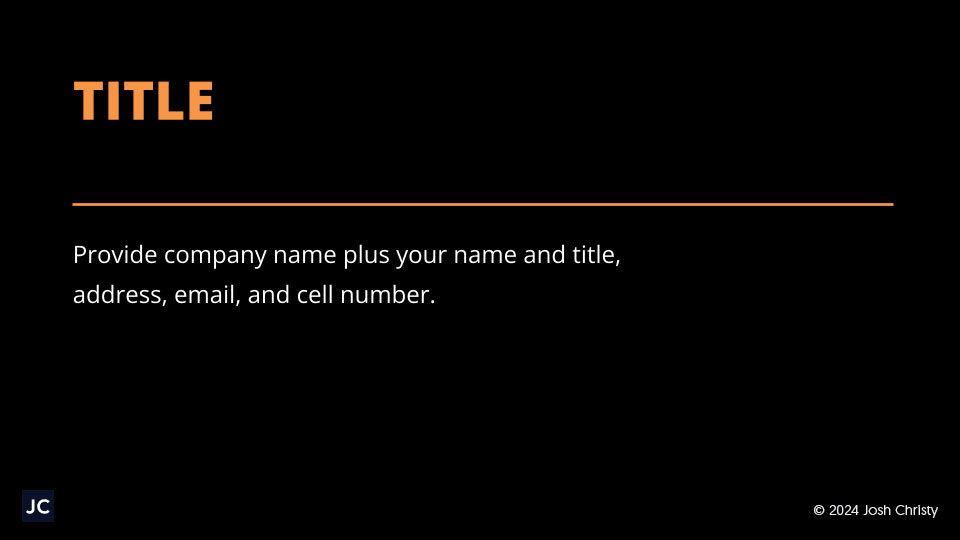
1. Title (~30 seconds)
Your title slide should feature your business’ name and logo as well as your name and title. Other good information to include is contact info (address, email, phone number, website, etc).
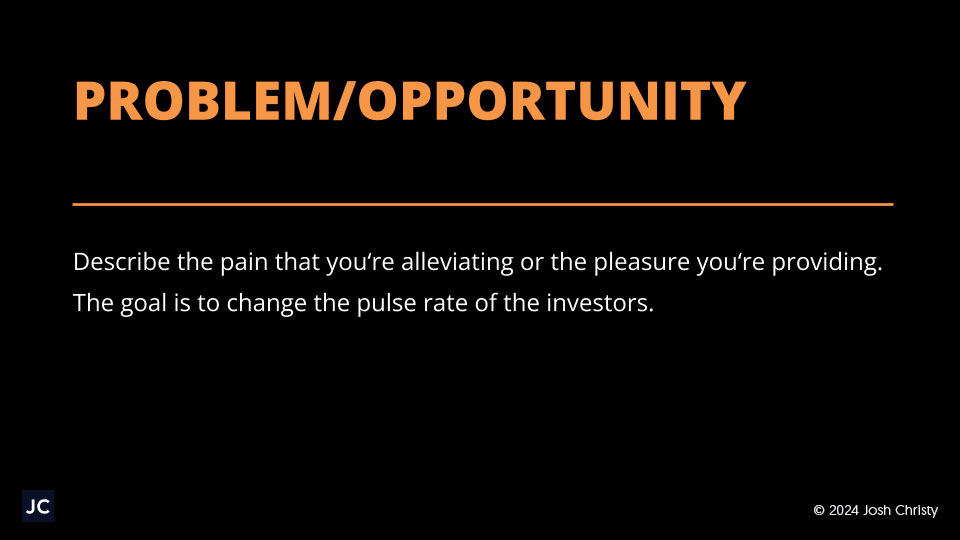
2. Problem/Opportunity (~2 minute)
Describe the pain points that you aim to fix with your product and/or the pleasurable, unique opportunities you’re providing. You’re trying to strike your audience’s attention and help them connect to your target market’s woes.
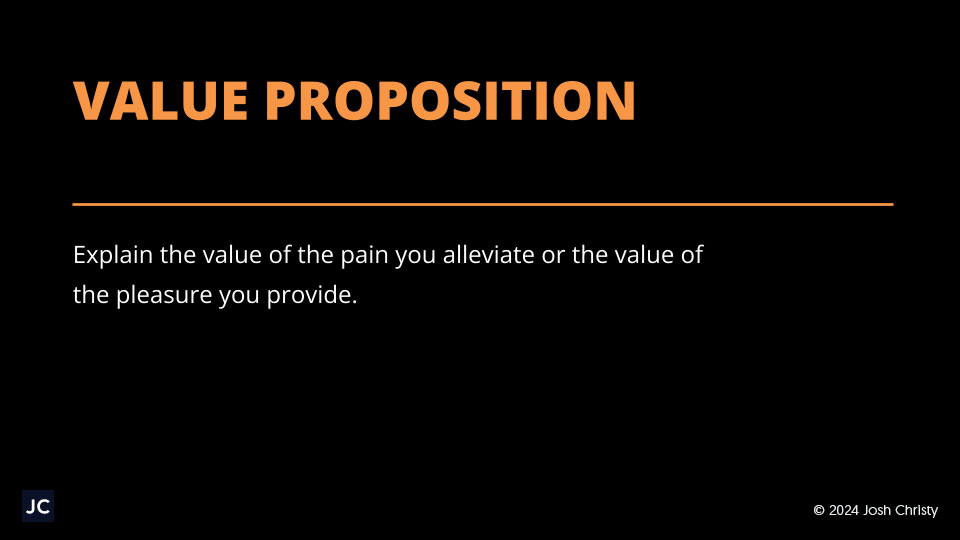
3. Value Proposition (~2 minutes)
Share the value of the problems you’re solving or the value of pleasures you’re bringing to the table. Explain why your solution is the right choice for the target market and why you are going to be the best fit for their needs.
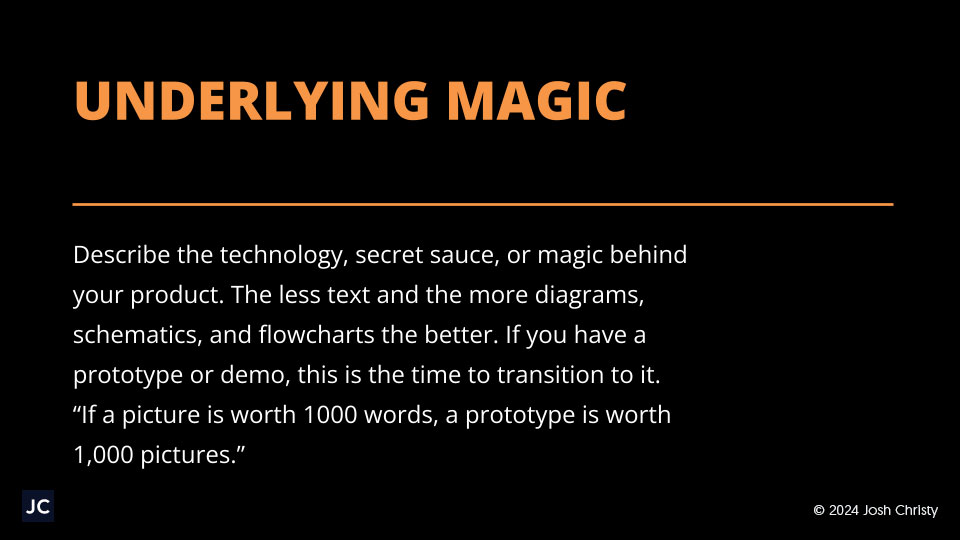
4. Underlying Magic (~2 minutes)
Describe what sets you apart from the crowd. Tell (and possibly show) them the magic behind your product. Try to include visuals or testimonials here to really make the most of your impact.
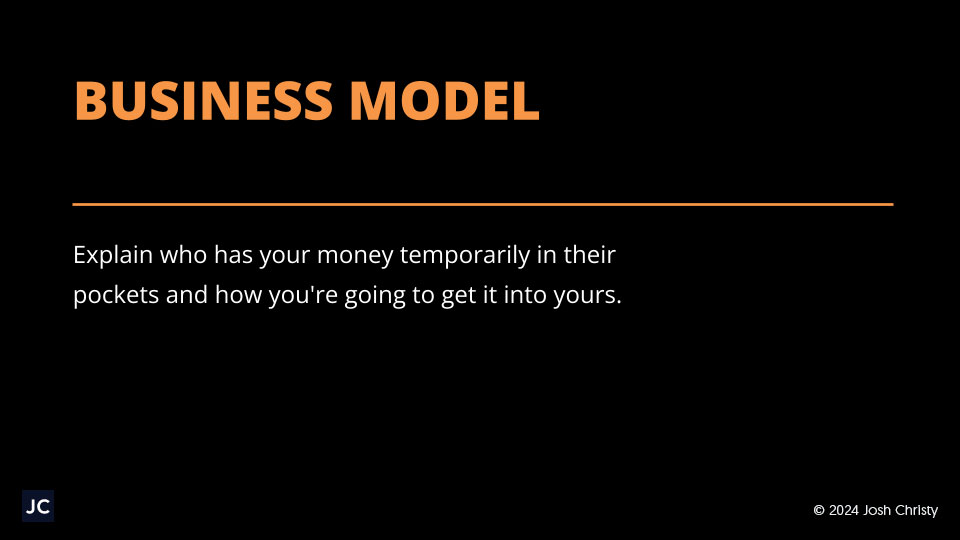
5. Business Model (~2 minutes)
Explain where the money is coming from currently, where revenue is coming from and what it’s going towards, and how you plan on getting the revenue into your pockets.
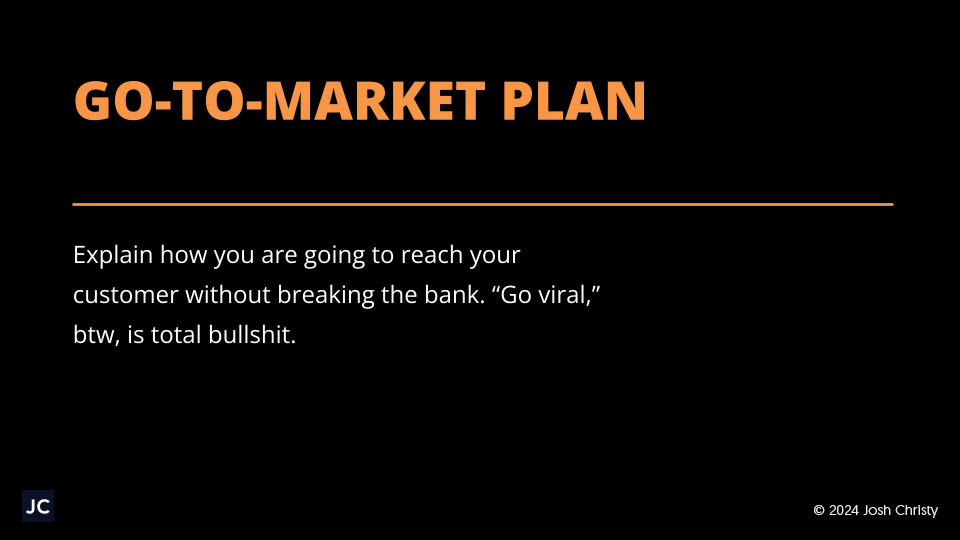
6. Go-To-Market Plan (~2 minutes)
Describe how you are going to hit the market, make a splash, and get in front of your target market without spending an arm and a leg.

7. Competitive Analysis (~2 minutes)
Share insight into your biggest competitors. Give their strengths as well as their weaknesses and how you can outshine them in the market. You could perform a SWOT analysis to get the information you need for this slide.
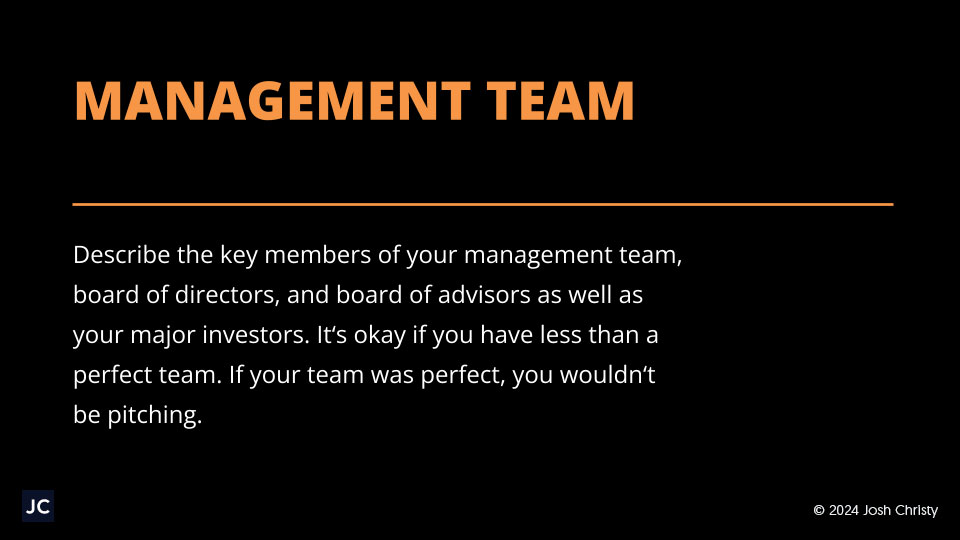
8. Management Team (~1 minute)
Share key members of your management team. This can include boards of directors, boards of advisors, and investors. It would not be a bad idea to share notable past experiences of your internal team here.
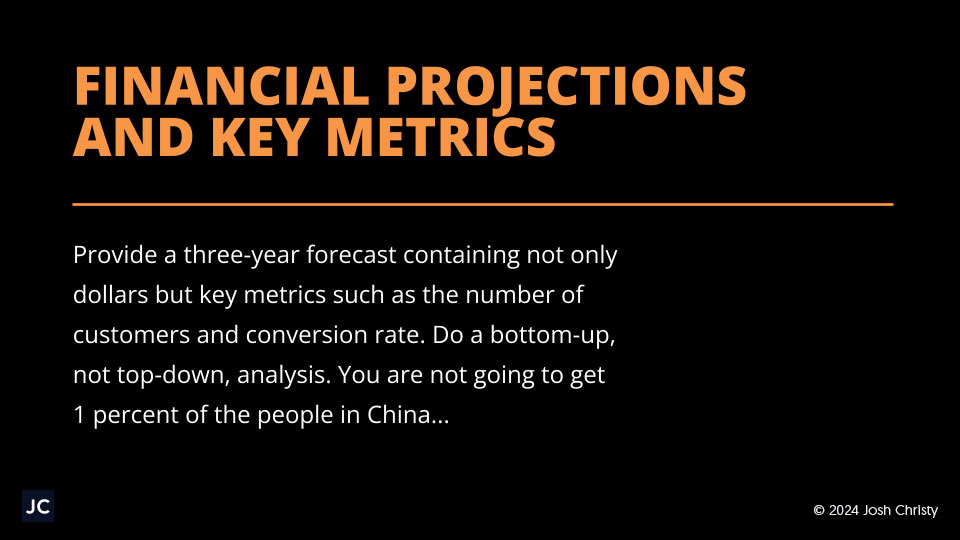
9. Financial Projections and Key Metrics (~2 minutes)
Share a 3-5 year outline of future projections highlighting revenue as well as other KPIs like size of user base and conversion rate. Let the numbers do the work to convince them!
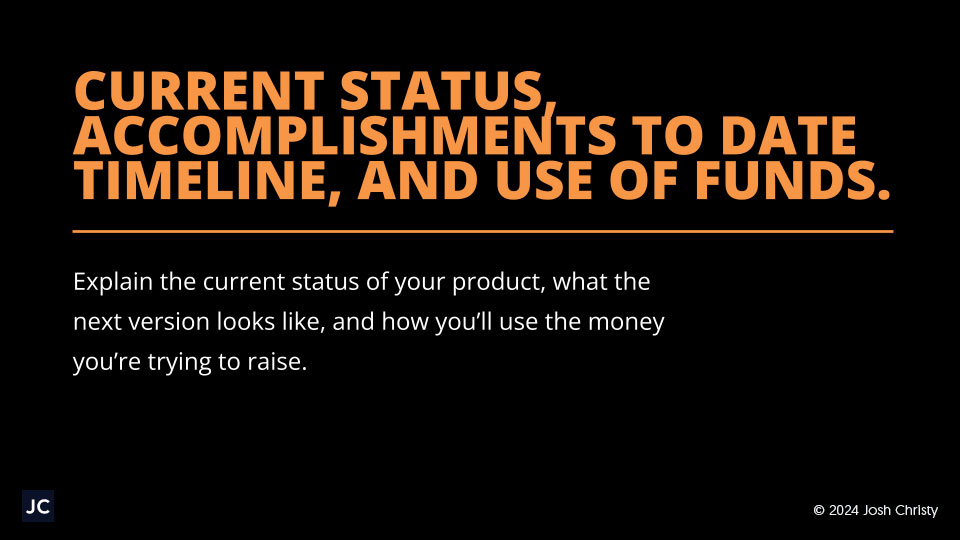
10. Current Status, Accomplishments To Date, Timeline, and Use of Funds (~3 minutes)
Share the current status of your product as well as any accomplishments you’ve achieved so far. Share upcoming improvements that are coming down the pipeline. Don’t forget to include how you plan on using incoming investments!
Other experts and guides recommend similar structure and slide topics as this for pitching. The thing to keep in mind is that you don’t have to use them verbatim. You may want two slides showcasing your underlying magic, or perhaps you want to include an entirely unique slide topic that you saw in an example pitch deck. Use these 10 as a jumping off point and make your pitch deck yours!
Common Mistakes to Avoid
Even the best ideas can get lost in a poorly executed pitch. Here are common pitfalls to avoid:
Jargon: While industry jargon and acronyms may sound impressive, you will either lose your audience’s attention while they try to figure out what you’re saying or you will spend too much time explaining the definition of these terms. Don’t be afraid to show your expertise but also connect with your audience on a human level.
Unrealistic Projections: Investors value honesty. Ensure your financials are realistic and backed by data. Use charts, infographics, and visuals to make data digestible and engaging.
Overloading Slides: Too much information can overwhelm your audience. Keep it clean and focused. Structure your slides like a narrative, guiding investors through your business journey.
Final Checklist for a Successful Pitch
Show off prototypes or demos of your product or software.
If possible at your stage, try having something that can show off the functionality and details of your product. Giving your audience the chance to step into the shoes of a consumer and see how your product looks and feels will make a more memorable experience.
Leave the audience with a memorable statement.
Have a notable soundbite about your product or software. Some investors see a multitude of pitches in a week or even just in a day. Creating a memorable moment can help your pitch stick in their minds.
Make your deck visually appealing.
A poorly designed deck can hurt your credibility. Invest time in making it look professional. Stick to a cohesive color palette, font style, and branding throughout. Including images and graphs help visual learners absorb the information you’re sharing. Using consistent font, font size, and colors not only help your presentation look nice, but also makes you look professional. Others can tell that you took time and care to prepare the pitch. If you have branding around your product, opt for your brand’s colors, fonts, and tone!
Send your pitch deck ahead of time!
Give the investor time to review your pitch deck and get interested in your project before you even step in the door. This can help them formulate questions to ask you during your pitch. Send your pitch deck in PDF form so that it’s easily accessible rather than linking through Dropbox or Google Docs. This also means that they have it on hand to review after your presentation.
By keeping your story clear, your design professional, and your delivery passionate, you can make an unforgettable impression.
Your pitch deck isn’t just about getting investors to write a check—it’s about getting them excited about your vision. By following these tips, you’ll not only capture your audience’s attention but also inspire their confidence in your vision.
